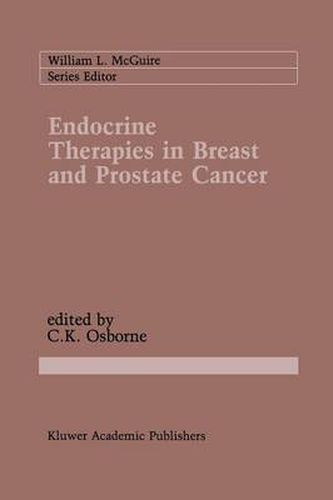Readings Newsletter
Become a Readings Member to make your shopping experience even easier.
Sign in or sign up for free!
You’re not far away from qualifying for FREE standard shipping within Australia
You’ve qualified for FREE standard shipping within Australia
The cart is loading…






This title is printed to order. This book may have been self-published. If so, we cannot guarantee the quality of the content. In the main most books will have gone through the editing process however some may not. We therefore suggest that you be aware of this before ordering this book. If in doubt check either the author or publisher’s details as we are unable to accept any returns unless they are faulty. Please contact us if you have any questions.
It has been recognized for many years that cancers originating in the breast and prostate gland are frequently ‘endocrine-dependent. ’ Traditional thera pies included surgical endocrine ablative procedures or pharmacologic hor mone administration, both designed to antagonize the stimulatory effects of sex steroid hormones. In the past decade, several new treatment strategies for these tumors have emerged from basic studies in reproductive biology and mechanisms of action of steroid hormones. In some instances, these new treatments have elimin ated or reduced the need for major surgical ablative procedures or for toxic hormone therapy. The clinical role for other new treatments has not yet been clearly defined, although exciting preliminary data from recent clinical trials are now available. Thus, an objective review of the current status of these new therapeutic approaches is of interest. In this volume we have attempted to provide an in-depth review of both basic and clinical research involving several new treatment strategies for breast and prostate cancer. The first three chapters summarize preclinical and clinical studies of the luteinizing hormone-releasing hormone analogues, which can be used effectively to induce ‘medical castration. ’ Chapters 4, 5, and 6 review the rationale and clinical use of the compounds known collec tively as the aromatase inhibitors, which can also be used to suppress sex steroid hormone levels. Antiestrogen mechanism of action and its clinical implications for the design of innovative treatment approaches is considered in chapters 7 and 8.
$9.00 standard shipping within Australia
FREE standard shipping within Australia for orders over $100.00
Express & International shipping calculated at checkout
This title is printed to order. This book may have been self-published. If so, we cannot guarantee the quality of the content. In the main most books will have gone through the editing process however some may not. We therefore suggest that you be aware of this before ordering this book. If in doubt check either the author or publisher’s details as we are unable to accept any returns unless they are faulty. Please contact us if you have any questions.
It has been recognized for many years that cancers originating in the breast and prostate gland are frequently ‘endocrine-dependent. ’ Traditional thera pies included surgical endocrine ablative procedures or pharmacologic hor mone administration, both designed to antagonize the stimulatory effects of sex steroid hormones. In the past decade, several new treatment strategies for these tumors have emerged from basic studies in reproductive biology and mechanisms of action of steroid hormones. In some instances, these new treatments have elimin ated or reduced the need for major surgical ablative procedures or for toxic hormone therapy. The clinical role for other new treatments has not yet been clearly defined, although exciting preliminary data from recent clinical trials are now available. Thus, an objective review of the current status of these new therapeutic approaches is of interest. In this volume we have attempted to provide an in-depth review of both basic and clinical research involving several new treatment strategies for breast and prostate cancer. The first three chapters summarize preclinical and clinical studies of the luteinizing hormone-releasing hormone analogues, which can be used effectively to induce ‘medical castration. ’ Chapters 4, 5, and 6 review the rationale and clinical use of the compounds known collec tively as the aromatase inhibitors, which can also be used to suppress sex steroid hormone levels. Antiestrogen mechanism of action and its clinical implications for the design of innovative treatment approaches is considered in chapters 7 and 8.